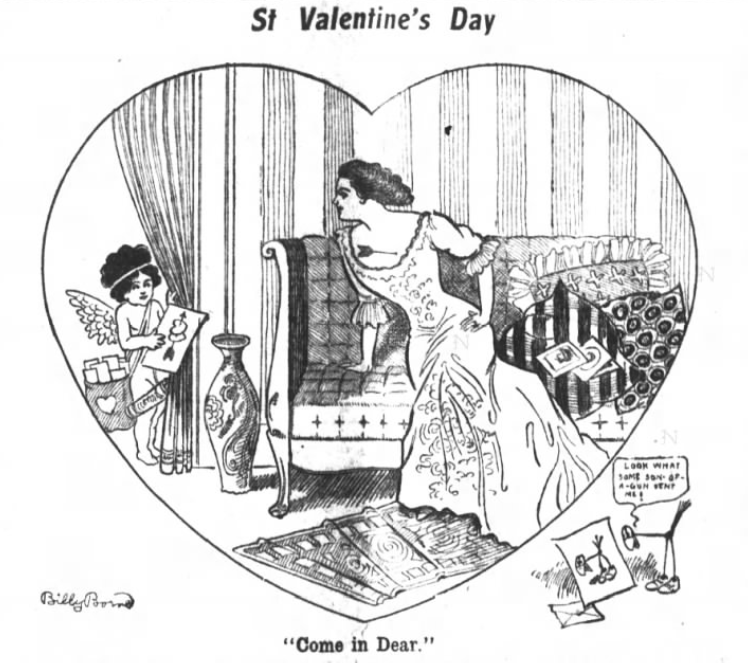On Feb. 14, 1910, The Asheville Citizen declared:
“Today is the day when the bashful swain and the coy maiden are permitted to confess the ardor that is in them, and today is the day when one can in all the secrecy of anonymity get even with worst enemies. For it is St. Valentine’s day, and by strange perversion of things which links opposites together, the day has become one of sentiment both amorous and inimical.”
The doting portion of the holiday should come as no surprise to contemporary readers. But the vindictive element previously associated with Valentine’s Day is likely unfamiliar to most. Fortunately, reporters from the early part of the 20th century left detailed accounts of this lost tradition.
“The comic valentine is an instrument of torture,” the 1910 article continued. The sort of man responsible for promulgating such animosity, the paper speculated, “must have been a pessimist with a grudge against the world.” And though many of these cards were sent in jest, the newspaper noted, “there is in it a drop of caustic that burns into the soul. Usually the comic valentine is selected to ridicule the very spot one is most sensitive about, and that is why it hurts, because of its truth.”
Similar coverage of the comic valentine continued in the local paper throughout the 1910s. By 1914, general reaction to the spiteful greetings appear to have tempered, softened perhaps by the more pressing and imminent potential for world war.
That year The Asheville Citizen wrote:
“Caricatures in many colors and accompanied by expressions that would start a riot at a meeting in the interest of international peace were they made in public will not cause the recipients to get angry today, for they will refuse to worry over unsigned attacks on St. Valentine’s day. They will figure that it’s part of the celebration and pass it up at that.”
By 1915, with bloodshed in Europe, enthusiasm for the vitriolic drawings appears to have waned. “The use of the comic valentines … gradually is passing and observant ones say that it will be a matter of only a few years until the comic valentine will be things of the past,” The Sunday Citizen observed.
Two years later, with the U.S. on the cusp of joining its European allies on the Western Front, tolerance for the comic valentine vanished among most consumers. All across town, the 1917 paper reported, shop windows displayed “very beautiful and attractive” tokens of love.
However, the article noted, inside many of these same businesses the comic valentine continued to be sold on account of its ongoing popularity among young boys. “Unfortunately,” the paper wrote, “the United States government, which watches so closely the use of its mail service, has not so far placed the ban on this class of mail.”
Yet by the article’s conclusion, its rather mercurial writer seems resolved to accept both modes of expression, writing:
“The songs of the birds are always heard more clearly on St. Valentine’s day, and their songs will be echoed and re-echoed in the hearts of others who receive valentines with the boldest and most declarations of everlasting love inscribed on them.
This, however, will not apply to those who receive the other kind. Their first inclination is ever to get a gun and walk abroad. Their next feeling is one of despair that they have lived all these years only to be classed with that thing they see staring back at them from the printed sheet. Finally, they make up their minds to discover the sender of the comic valentine and to secure sweet revenge by sending a return valentine next year.”
The following year, 1918, America was in the throes of trench warfare. For this reason, it appears Valentine’s Day coverage was limited to brief mentions of school-related events and social gatherings.
Editor’s note: Peculiarities of spelling and punctuation are preserved from the original text.




Before you comment
The comments section is here to provide a platform for civil dialogue on the issues we face together as a local community. Xpress is committed to offering this platform for all voices, but when the tone of the discussion gets nasty or strays off topic, we believe many people choose not to participate. Xpress editors are determined to moderate comments to ensure a constructive interchange is maintained. All comments judged not to be in keeping with the spirit of civil discourse will be removed and repeat violators will be banned. See here for our terms of service. Thank you for being part of this effort to promote respectful discussion.